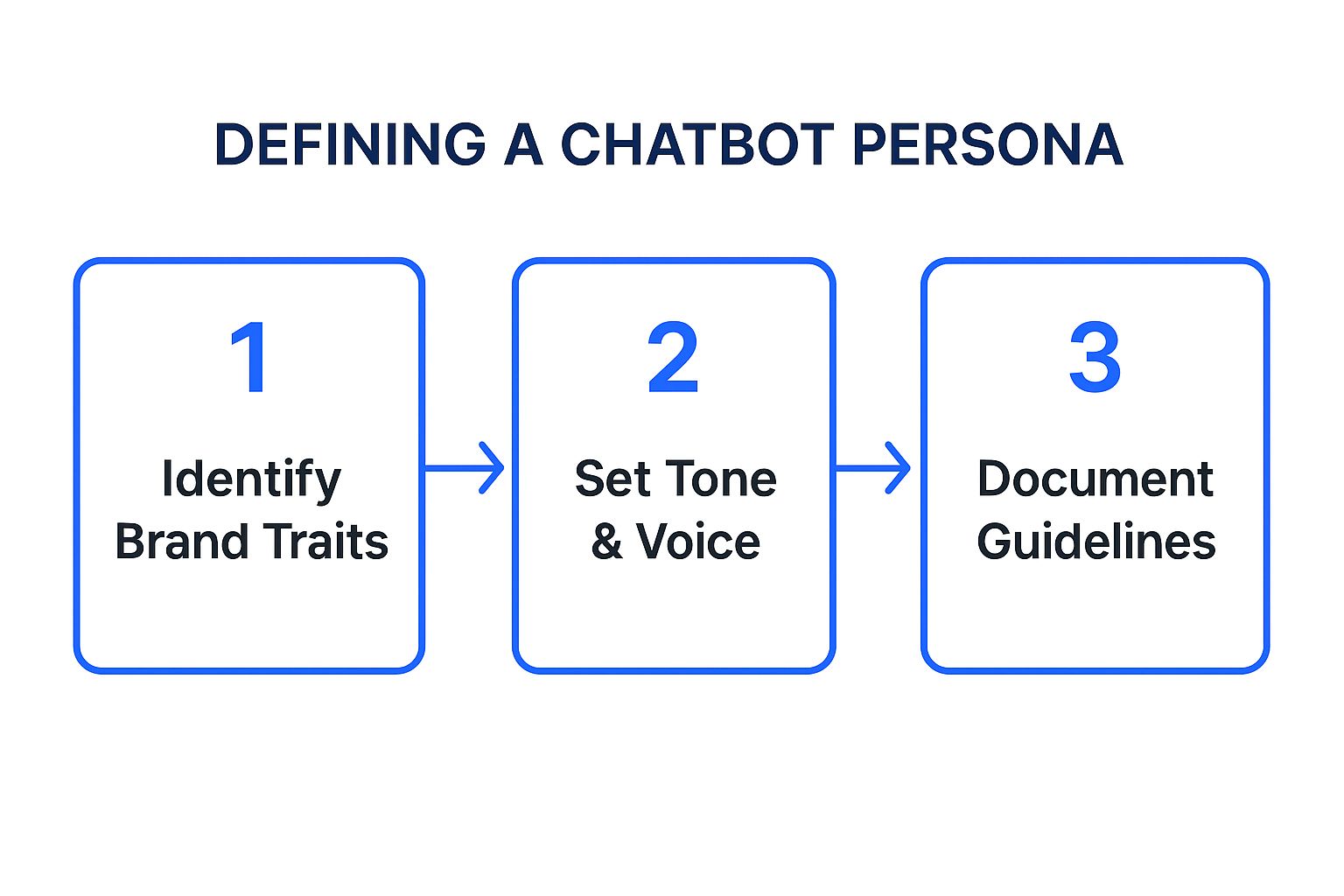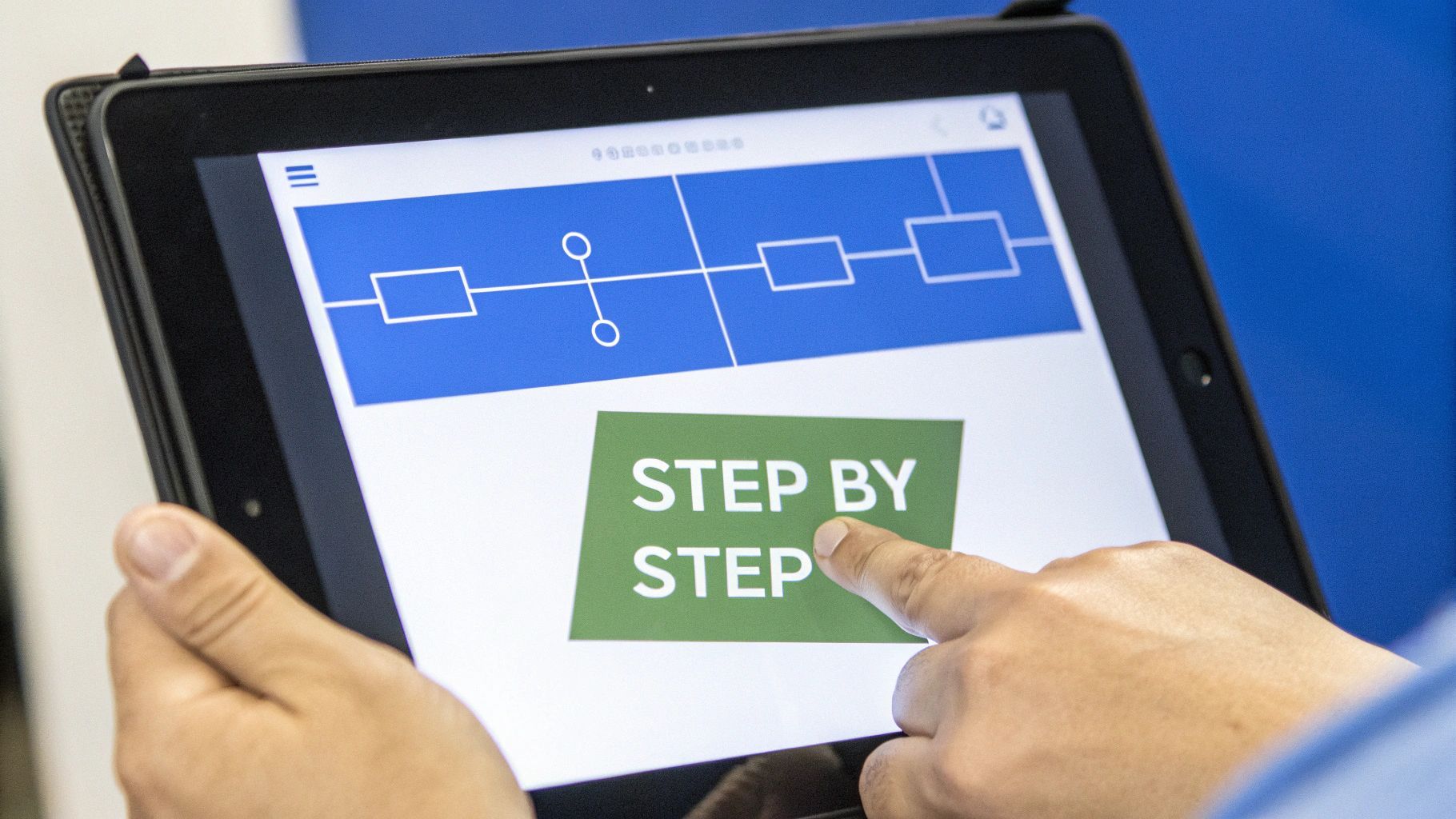
7 Essential Chat Bot Best Practices for 2025
Discuss with AI
Get instant insights and ask questions about this topic with AI assistants.
💡 Pro tip: All options include context about this blog post. Feel free to modify the prompt to ask more specific questions!
In today's fast-paced digital marketplace, a simple chat bot is no longer enough. Customers expect seamless, intelligent, and personalized interactions that solve their problems and anticipate their needs. But transitioning from a clunky, frustrating bot to a sophisticated AI assistant requires more than just advanced technology. It demands a strategic approach grounded in proven principles. This guide cuts through the noise to deliver a definitive list of chat bot best practices essential for modern business.
We will explore seven critical strategies that empower businesses to design, deploy, and continuously optimize chat bots that not only handle queries but also build brand loyalty and drive conversions. These techniques are rooted in the practical application of conversational AI. Para profundizar en los fundamentos de cómo la IA está transformando las interacciones, puedes explorar un artículo sobre Inteligencia Artificial Conversacional.
From defining a clear bot persona to implementing seamless human handoffs and leveraging analytics for continuous improvement, each point is designed to be actionable. Whether you're a customer support manager, a marketer, or a D2C store owner, mastering these practices will unlock the full potential of your conversational AI and help you create truly exceptional customer experiences.
Before writing a single line of dialogue, one of the most critical chat bot best practices is to establish a distinct persona. A chatbot without a defined personality is like a customer service agent with no training; it feels generic, disconnected, and can undermine user trust. A well-defined persona ensures every interaction is consistent, aligns with your brand voice, and creates a more engaging, human-like experience.
Think of your chatbot as a new employee. You would define their role, communication style, and how they should represent the brand. This same process applies to your AI. Is your bot a formal and professional financial advisor like Bank of America’s Erica, or is it a fun-loving music enthusiast like Spotify’s virtual assistant? This foundational decision influences everything from its vocabulary and sentence structure to its use of emojis and humor.
A strong persona goes beyond just being "friendly." It requires a documented guide that details the bot's character traits, tone of voice, and even what it shouldn't say. This guide becomes the "source of truth" for developers, content writers, and customer service teams, ensuring a cohesive user experience across all touchpoints.
To build a memorable and effective bot personality, follow a structured process. The following infographic illustrates the three core steps to take your brand’s essence and translate it into a documented chatbot persona.

This simple, sequential process ensures your bot's personality is not an afterthought but a strategic asset rooted in your core brand identity.
- Create Detailed Persona Documentation: Develop a comprehensive guide that outlines the bot's name, backstory (optional but helpful), core personality traits (e.g., patient, witty, formal), vocabulary, and response etiquette.
- Test with Focus Groups: Before a full launch, test your bot's personality with a small segment of your target audience. Gather feedback on whether the tone feels authentic and helpful, not annoying or unnatural.
- Audit Conversations Regularly: Periodically review conversation logs to ensure the bot's responses remain consistent with the established persona. This helps catch any deviations or areas where the personality falls flat.
A common mistake in chatbot design is overwhelming users with too much information at once. One of the most effective chat bot best practices is to implement progressive disclosure, a technique that reveals information gradually as the user needs it. Instead of presenting a long menu of options, the bot guides the user through a logical sequence, asking one question at a time. This approach simplifies the interface, reduces cognitive load, and makes the interaction feel more like a natural conversation.
This method is crucial for creating a smooth and intuitive user journey. Think of how Amtrak's chatbot, Julie, guides you through booking a ticket; it doesn't ask for your destination, date, time, and passenger details all at once. It breaks the process into manageable steps, ensuring clarity and minimizing user error. This sequential flow is fundamental to user experience, preventing the user from feeling lost or confused by too many choices.

Effective progressive disclosure requires careful planning of the conversation flow. This means mapping out potential user journeys and designing conversational paths that are both efficient and intuitive. The goal is to anticipate user needs and guide them to their desired outcome with the least amount of friction possible. A well-designed flow feels helpful and proactive, not restrictive.
By breaking down complex tasks into smaller, sequential steps, you make the process more manageable and less intimidating. This is particularly important for tasks like making a purchase, booking an appointment, or troubleshooting an issue. As demonstrated by principles from UX leaders like Jakob Nielsen and platforms like Google's Dialogflow, simplicity is key to user retention.
- Map the User Journey First: Before writing any dialogue, create a flowchart of the entire conversation. Identify the main goal and break it down into logical steps and decision points.
- Analyze Conversation Drop-off Points: Use analytics to see where users abandon conversations. These points often indicate that the flow is confusing or the options are overwhelming, highlighting areas that need simplification.
- Provide 'Skip Ahead' Shortcuts: For experienced or returning users, offer ways to bypass introductory steps. For instance, a user could type "reorder my last purchase" to skip several verification steps.
- Implement Breadcrumb Navigation: In longer, multi-step processes like a detailed insurance quote, show users where they are in the process (e.g., "Step 3 of 5: Vehicle Details") to manage expectations and reduce abandonment. You can learn more about how to structure these interactions within a chat interface on spurnow.com.
No matter how advanced your AI is, one of the most critical chat bot best practices is planning for its limitations. A seamless human handoff strategy ensures that when a chatbot can't resolve an issue or when a user explicitly requests human help, the transition to a live agent is smooth, efficient, and frustration-free. This process prevents dead-end conversations that damage customer satisfaction and lead to churn.
A poorly managed handoff forces users to repeat themselves, creating a disjointed and irritating experience. In contrast, a well-designed escalation path, like those used by Freshworks or Zendesk, transfers the full conversation context, so the human agent is immediately up to speed. This transforms a potential point of failure into a demonstration of excellent, integrated customer service, reinforcing user trust in your brand's support ecosystem.
A successful handoff is not just a feature; it's a core component of your conversational design. It requires clear triggers, intelligent routing, and robust agent-side tools. The goal is to make the transition feel like a natural continuation of the conversation, not a system breakdown. This strategy acknowledges the bot's role as a first line of defense, designed to assist and filter inquiries, with human experts ready to handle more complex or sensitive situations.
Platforms like Intercom and LivePerson have pioneered this by building their systems around the synergy between bot and human. They use AI not just to deflect tickets but to gather initial information, qualify leads, and route customers to the correct department with all necessary context intact, making the human agent's job easier and more effective.
- Preserve and Transfer Context: Ensure the entire chat history, including any information the user has already provided (like order number or email), is automatically passed to the human agent. This is the single most important factor in a successful handoff.
- Set Clear Escalation Triggers: Define specific conditions for handoff. This can include keyword triggers ("speak to a human"), sentiment analysis (detecting user frustration), or after a set number of failed attempts to understand a query.
- Manage User Expectations: Clearly inform the user they are being transferred. Provide an estimated wait time for a human agent to join the chat to prevent impatience and abandonment.
- Train Agents on Bot Capabilities: Human agents should understand what the chatbot can and cannot do. This knowledge helps them take over conversations smoothly and provide feedback for improving the bot's performance.
No matter how intelligent a chatbot is, it will inevitably encounter questions it cannot answer or commands it doesn't understand. A crucial aspect of chat bot best practices is planning for these failures. Comprehensive error handling ensures that when the bot gets stuck, it doesn't lead to a dead-end conversation but instead guides the user back to a productive path gracefully. This builds resilience and user trust.
A bot that simply repeats "I don't understand" creates a frustrating and repetitive loop, causing users to abandon the conversation. A well-designed error system, however, acknowledges the failure, offers helpful alternatives, and maintains the bot's persona. Think of how Google Assistant, instead of just failing, might say, "I'm not sure how to help with that, but I can search the web for you." This approach turns a potential failure into a helpful pivot.
Effective error handling is about designing recovery, not just reporting failure. It involves anticipating where users might go off-script and creating a safety net. This means having a tiered system of fallback responses that prevent the user from getting stuck while transparently managing their expectations about the bot's capabilities.
This system should not only handle user misunderstandings but also technical glitches, like an API failing to respond. The bot should be able to communicate these issues without alarming the user, perhaps suggesting they try again in a moment. By proactively managing these scenarios, you maintain a seamless and professional user experience, even when things go wrong behind the scenes.
- Create Tiered Fallback Responses: Develop multiple levels of error messages. The first time the bot fails, it might ask for rephrasing. The second time, it could offer buttons with suggested actions. The third time, it should offer an escalation path, like connecting to a human agent.
- Use Errors to Guide Users: Frame error messages as helpful guidance. Instead of "Invalid input," try "I can help you with tracking an order, browsing products, or checking our store hours. Which would you like?"
- Log and Analyze Failures: Implement robust logging to track every time a fallback is triggered. Regularly review these logs to identify common user-intent failures and use this data to improve the bot’s NLU model and conversational flows.
- Provide Clear Alternatives: When a request is outside the bot's scope, it should state its limitations clearly and offer what it can do. For example, "I can't process refunds myself, but I can connect you to a support agent who can."
In today's fragmented digital landscape, users expect a seamless experience whether they interact with your brand on a website, mobile app, or social media platform. This makes multi-channel consistency and integration one of the most vital chat bot best practices for modern businesses. It ensures that a customer's conversation can start on one channel and continue on another without losing context, history, or functionality.
This unified approach prevents the disjointed and frustrating experience of re-explaining an issue or re-entering information. For example, a customer might start a query on your website's chatbot and later follow up via Facebook Messenger. A well-integrated system recognizes the user and retrieves their conversation history, creating a single, continuous dialogue. This not only enhances user satisfaction but also reinforces a cohesive brand presence across all digital touchpoints.

This centralized architecture, powered by platforms like Salesforce Einstein or the Microsoft Bot Framework, allows companies like American Express and KLM to offer consistent virtual assistance across their entire digital ecosystem.
True multi-channel consistency is about more than just having a bot on different platforms; it's about a shared "brain" that powers them all. This brain should be connected to your core business systems, like your CRM and inventory management, to provide accurate, real-time information. For instance, integrating WhatsApp with CRM systems is a powerful strategy to maintain a unified customer profile and conversation history, regardless of the entry point. This integration ensures that every interaction adds value to the customer relationship.
By building a system where data and context are synchronized, you create a truly omnichannel experience. A bot that remembers a user's past purchases or preferences across channels feels less like a script and more like a genuinely helpful personal assistant, significantly boosting engagement and loyalty.
- Use APIs for Data Synchronization: Implement robust APIs to ensure user data, conversation history, and preferences are synchronized in real-time across all channels and connected to a central database or CRM.
- Design for the Lowest Common Denominator: When developing features, consider the limitations of each platform. Design core functionality to work on the most restrictive channel (e.g., SMS) and then enhance it with richer features (like buttons or carousels) for more capable platforms.
- Centralize Content Management: Manage your bot's dialogue, responses, and knowledge base from a single location. This ensures that an update to a policy or product information is instantly reflected across all channels, maintaining consistency.
- Test Cross-Channel User Flows: Actively test user journeys that span multiple touchpoints. For example, start a support ticket on the website chatbot and try to get an update on it via a WhatsApp bot to ensure the handover is seamless.
Deploying a chatbot is not the final step; it's the beginning of an ongoing optimization cycle. One of the most critical chat bot best practices is to treat your bot as a living product that evolves through continuous learning. By implementing robust analytics and feedback systems, you can transform real user interaction data into actionable insights, ensuring your bot becomes smarter, more efficient, and more helpful over time.
Without a data-driven approach, a chatbot's performance will stagnate or even degrade as user expectations and business needs change. Much like Netflix’s chatbot learns from viewing habits to refine recommendations, your bot should learn from every conversation. This iterative process is what separates a basic, static bot from a truly intelligent virtual assistant that delivers tangible business value.
The core of this practice is a feedback loop: monitor performance, analyze user behavior, and use the findings to improve the bot's knowledge base, conversation flows, and NLP model. This systematic approach ensures your bot doesn't just answer questions but actively learns from them. It helps identify common points of failure, uncover new user intents, and pinpoint where conversations are being escalated to human agents unnecessarily.
For example, a Duolingo chatbot adapts its teaching style based on a student's progress, creating a personalized learning path. Similarly, your customer support bot can identify the most frequent unresolved issues and use that data to build out new, effective response flows, reducing the burden on human agents and improving first-contact resolution rates. Learn more about how this fits into a broader strategy of customer service automation.
- Define Clear KPIs Before Launch: Establish key performance indicators such as containment rate, user satisfaction (CSAT) scores, session duration, and goal completion rate. These metrics will be your north star for measuring success.
- Implement In-Conversation Feedback: Add simple feedback mechanisms at the end of key interactions, such as a thumbs-up/thumbs-down or a short survey. This provides direct, immediate insight into user sentiment.
- Analyze Conversation Logs for Intent Gaps: Regularly review conversations where the bot failed or misunderstood the user. This "not understood" analysis is a goldmine for identifying new intents and phrases to add to your training data.
- Conduct A/B Testing on Responses: Test different versions of your bot’s welcome messages, clarification questions, and key responses to see which ones perform better against your KPIs.
In an era of increasing data scrutiny, another of the most critical chat bot best practices is to build with privacy at the core. A privacy-first approach means that data protection isn't an afterthought or a feature to be added later; it is a foundational principle guiding the entire design, development, and deployment process. This proactive stance not only ensures compliance with regulations like GDPR and CCPA but also builds crucial user trust, a priceless asset in the digital age.
Users are more aware than ever of how their data is collected and used. A chatbot that is opaque about its data handling or requests excessive information can quickly drive users away and damage your brand's reputation. By prioritizing privacy, you demonstrate respect for your customers and differentiate your service as a trustworthy partner. This approach is exemplified by platforms like Signal, whose assistants operate within a strictly encrypted and privacy-preserving framework.
Adopting a "privacy by design" methodology means every decision, from data storage to conversation flow, is evaluated through a privacy lens. It involves transparently communicating what data you are collecting and why, securing that data rigorously, and giving users clear control over their information. This commitment ensures your chatbot is not just functional but also ethical and secure.
To effectively integrate privacy, you must create clear, accessible policies and implement robust technical safeguards. The goal is to make your chatbot a safe and secure channel for interaction, where users feel confident sharing the information needed to resolve their queries without fearing misuse.
- Implement Privacy by Design: Start the development process with a privacy impact assessment. Map out all potential user data touchpoints and build safeguards, such as data minimization and end-to-end encryption, from day one.
- Provide Clear and Accessible Privacy Policies: Don't bury your data policies in fine print. Use plain language to explain what data is collected, how it's used, and how long it's stored. Make this information easily accessible from within the chat interface.
- Offer Granular User Consent: Ask for consent explicitly before collecting any sensitive information. Provide users with clear options to opt in or out of data collection and allow them to easily view or delete their conversation history.
- Conduct Regular Security Audits: Continuously audit your data handling practices, encryption protocols, and third-party integrations to identify and patch vulnerabilities. Stay informed about evolving global privacy regulations to ensure ongoing compliance.
Aspect Define Clear Bot Persona and Personality Implement Progressive Disclosure and Conversation Flow Seamless Human Handoff Strategy Comprehensive Error Handling and Fallback Responses Multi-Channel Consistency and Integration Continuous Learning and Analytics-Driven Optimization Privacy-First Design and Data Protection Implementation Complexity 🔄 Medium to High: Requires upfront detailed design and ongoing upkeep Medium to High: Complex conversation trees need careful mapping Medium: Technical coordination between bot and agents needed High: Extensive scenario planning and testing required High: Complex multi-platform integration and coordination High: Requires analytics infrastructure and ongoing data work Medium to High: Needs privacy-by-design and compliance efforts Resource Requirements ⚡ Moderate: Design and content teams plus consistent training Moderate: Conversation designers and analytics resources High: Human agent workforce and system integration High: Development and QA resources for fallback strategies High: Cross-team collaboration and API development High: Data scientists, analysts, and engineers Moderate: Compliance, legal, and security resources Expected Outcomes 📊 Strong brand alignment, trust, user satisfaction ⭐⭐⭐⭐ Improved user engagement, reduced overwhelm, better task flows ⭐⭐⭐⭐ Increased user satisfaction and issue resolution through humans ⭐⭐⭐ Reduced frustration, smoother recovery, increased engagement ⭐⭐⭐⭐ Seamless cross-channel experience, consistent brand presence ⭐⭐⭐⭐ Improved bot accuracy, data-driven insights, and ROI ⭐⭐⭐⭐ Enhanced user trust and regulatory compliance ⭐⭐⭐⭐ Ideal Use Cases 💡 Brand-centric bots needing distinct personality and voice Multi-step interactions needing clear guidance and simplicity Complex support scenarios requiring human expertise Bots prone to misunderstandings or high error rates Organizations needing unified omnichannel presence Bots requiring continuous improvement and performance tracking Bots handling sensitive data or operating in regulated sectors Key Advantages ⭐ Memorable UX, loyalty, differentiated experience Natural flow, reduced decision fatigue, scalable conversations Maintains satisfaction, reduces frustration, improves service Maintains engagement despite errors, improves bot intelligence Consistent user experience, data unification, brand consistency Data-driven improvement, detailed insights, user satisfaction Builds trust, reduces legal risk, protects user privacy
The journey to an exceptional AI assistant is not a destination but a continuous cycle of improvement. Implementing these chat bot best practices is the foundational blueprint for transforming a simple automated tool into a powerful engine for customer engagement and business growth. We've explored the critical pillars that support a successful conversational AI strategy, moving far beyond basic question-and-answer scripts.
The core takeaway is that a truly effective chat bot is a strategic blend of personality, functionality, and intelligence. It requires a thoughtful approach that considers every facet of the user experience. By defining a clear bot persona, you give your brand a consistent voice. By mastering conversation flow with progressive disclosure, you guide users naturally toward their goals without overwhelming them. These elements work in tandem to create interactions that feel less robotic and more human.
Ultimately, the difference between a frustrating bot and a helpful one lies in the details. A seamless human handoff strategy, for instance, isn't just a feature; it's a commitment to your customer, ensuring they are never left at a dead end. Likewise, comprehensive error handling demonstrates foresight and respect for the user's time, turning potential moments of failure into opportunities to gracefully recover the conversation.
Remember, your chat bot doesn't operate in a vacuum. Achieving multi-channel consistency ensures that your brand provides a unified, reliable experience whether a customer engages on your website, a social media platform, or a messaging app. This holistic view is crucial for building trust and brand loyalty in a fragmented digital landscape.
The most critical long-term strategy is a commitment to data. Your chat bot is a living asset that generates invaluable insights with every interaction. Embracing a cycle of continuous learning, driven by robust analytics, is the definitive path to sustained success. This data-driven approach allows you to refine responses, identify new user needs, and proactively improve performance, ensuring your bot evolves alongside your customers.
Underpinning all of these technical and strategic elements is the non-negotiable principle of privacy-first design. In an era of heightened data sensitivity, building and maintaining user trust is paramount. Transparent data handling and robust security are not just legal requirements; they are essential components of your brand's reputation. Applying these chat bot best practices collectively will not only enhance customer satisfaction and operational efficiency but will also position your brand as a forward-thinking, customer-centric leader.
Ready to put these best practices into action without the technical headache? Spur offers a powerful, no-code platform that makes it easy to build, deploy, and optimize intelligent chat bots across all your customer channels. Start your free trial and begin creating smarter, more effective customer conversations in minutes at Spur.
